
Berlin
29 November through 2 December 2001
Thursday 29 November 2001
We depart from Rotterdam around a quarter to seven in the morning. In Utrecht we change trains to the ICE, the high speed train, that takes us to Duisburg. The stretch in the Netherlands is highly high speed, in Germany the train takes up some speed. In Duisburg we have 40 minutes to change to the ICE for Berlin. After a few stops in the Ruhr area the train accellerates to about 250 km/hr (± 150 mph). We arive in Berlin around 1.30 pm. We get out at Berlin Ostbahnhof. It is immediatley clear that things have changed dramatically and with some expediency in Eastern Berlin, as the station looks brand new. It has been rid of its former East German facade and built up again. The roof is still original (± 1890). We buy a Berlin Welcomecard. This entitles us to 72 hrs limitless public transport (Bus, tram, metro en S-Bahn) and reduced entry to some attractions. It costs only E 18, which is a good deal, as a single ride cost E 2,10. We take the S-Bahn and the underground to the hotel. We stay at Pension Schall Und Rauch. Schall und Rauch is a (gay) café/bar/restaurant with a guest house on top. The etablishment luckily does not live up to its name (means noise and smoke): it is certainly not noisy nor very smoky. We move into our room that has been trendily furnished. A designer’s touch shows in every detail. Only the bathroom is very small, but the massage shower makes up for that. The guest house is located in the Prenzlauer Berg area north east of the centre. In de GDR-days the Prenzl or P'Berg was the epicentre of the dissident movement. The area has a face lift during the past 10 years and has become quite trendy. Old town houses have been restored to their pre-war glory and new ones have been added. It has become quite popular with a young well educated and earning crowd, which shows in the number of good shops, resaurants, art galleries etc.
We have a burger at McDonalds before set off for a visit to
the Reichstag. The Reichstag building was completed, as the seat of parliament,
in 1884 by the archtiect Paul Wallot. The facade’s motto
"Dem
Deutschen Volke" (for the German People) was not installed until 1916
because of the emp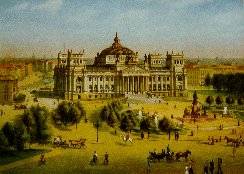 eror’s
opposition, when the emperor badly needed popular support becaus of the bad turn
the first world war had taken by then. The Reichstag
was badly damaged in 1933 during a fire, in which the dutchman Van der Lubbe
played a role that has never been totally uncovered. The dome collapsed during
the fire. During the restauration of the building after the war the dome was not
restored, but demolished. In 1991 it was decided to move the capital of a
reunited Germany to Berlin. In addition to that the Reichstag became the seat of
parliament again. The British architect Sir Brian Foster got the commision to
design a new dome. He
eror’s
opposition, when the emperor badly needed popular support becaus of the bad turn
the first world war had taken by then. The Reichstag
was badly damaged in 1933 during a fire, in which the dutchman Van der Lubbe
played a role that has never been totally uncovered. The dome collapsed during
the fire. During the restauration of the building after the war the dome was not
restored, but demolished. In 1991 it was decided to move the capital of a
reunited Germany to Berlin. In addition to that the Reichstag became the seat of
parliament again. The British architect Sir Brian Foster got the commision to
design a new dome. He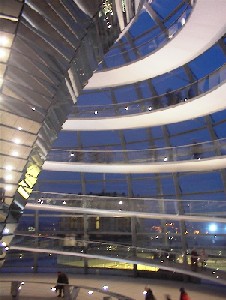 designed a modern dome of glass with a spiralling stairway to the top, which is
open to visitors. In 1997 the dome was completed. The dome, although heavily
critisized by some, has become one of the most popular tourist attractions in
the city. Entry is free and there is usually a long line to get in. In Berlin
the sun sets earlier than in the Netherlands and we notice that when we want to
get up to the dome at 3.30pm. It is getting dark and there is hardly any queue
at all, so were up there in no time at all. From the dome the view is excellent.
The dome itself is subtly lit and the glass transparent base of the dome allows
a view to the assembly itself. After our visit to the Reichtag we go back to the
guest house. We drink a cocktail inthe the bar (Schall und Rauch has a long
cocktail menu). After that we walk to a trendy Indian restaurant (Meena
Kumari), where we have a lovely modern Indinan dinner. After dinner we do a
brief tour of the gay
scene of Prenzlauer Berg: drinkjs in November en
Stiller Don.
designed a modern dome of glass with a spiralling stairway to the top, which is
open to visitors. In 1997 the dome was completed. The dome, although heavily
critisized by some, has become one of the most popular tourist attractions in
the city. Entry is free and there is usually a long line to get in. In Berlin
the sun sets earlier than in the Netherlands and we notice that when we want to
get up to the dome at 3.30pm. It is getting dark and there is hardly any queue
at all, so were up there in no time at all. From the dome the view is excellent.
The dome itself is subtly lit and the glass transparent base of the dome allows
a view to the assembly itself. After our visit to the Reichtag we go back to the
guest house. We drink a cocktail inthe the bar (Schall und Rauch has a long
cocktail menu). After that we walk to a trendy Indian restaurant (Meena
Kumari), where we have a lovely modern Indinan dinner. After dinner we do a
brief tour of the gay
scene of Prenzlauer Berg: drinkjs in November en
Stiller Don.
To bed early.
Friday 30 November 2001
We have a fine breakfast in Schall und Rauch. We take the
S-bahn to Unter den Linden. There we have a c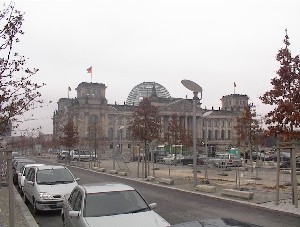 offee
and cake at a bakery shop. We start with a walk through the new centre of
Berlin, exploring the latest developments in the city. We start once more at the
Reichstag, which visited yesterday. Across from the Reichstag is the new
Chancellor’s office, the office of the Federal Chancellor (=prime minister;
now Gerhard Schröder). The building has become a bit grand in size, too grand
too the taste of many Berliners, including the present chancellor. The design
was heavily influenced by the former chancellor Helmut Kohl, who commissioned
it. We walk along the building in the direction of the Kongresshalle. The
Kongresshalle was built in het 1950s, but the roof collapsed in 1980 because of
a construction error. It has been repared and now houses the
Haus der
Kulturen der Welt (House of the Cultures of the World),
a theatre and
concert hall for performances from third world countries. We continue our walk
along the Spree river, the river that crosses the city and used be part of the
East/West divide. We walk past the Schlo
offee
and cake at a bakery shop. We start with a walk through the new centre of
Berlin, exploring the latest developments in the city. We start once more at the
Reichstag, which visited yesterday. Across from the Reichstag is the new
Chancellor’s office, the office of the Federal Chancellor (=prime minister;
now Gerhard Schröder). The building has become a bit grand in size, too grand
too the taste of many Berliners, including the present chancellor. The design
was heavily influenced by the former chancellor Helmut Kohl, who commissioned
it. We walk along the building in the direction of the Kongresshalle. The
Kongresshalle was built in het 1950s, but the roof collapsed in 1980 because of
a construction error. It has been repared and now houses the
Haus der
Kulturen der Welt (House of the Cultures of the World),
a theatre and
concert hall for performances from third world countries. We continue our walk
along the Spree river, the river that crosses the city and used be part of the
East/West divide. We walk past the Schlo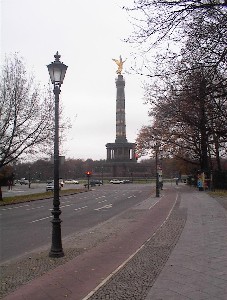 ß
Bellevue, the residence of the federal president, the German Head of State. It
bit further down is the Siegessaeule. This column was erected to celebrate the
Pruisian victory on the French in 1871. It was moved to this site on Hitler’s
orders to this site, now called Platz der Republik. The eagle on top faces
France. I climb the column, but the 545 steps are a heavy climb. The view,
however, is very nice, on the Tiergarten park, the Reichstag, the Cathedral and
other highlights. We walk on through the park Tiergarten towards the
Kulturforum. Tiergarten once was the private hunting ground for the Prussian
kings until it became a public park in the 18th century. It covers a wide area
with dense forest and sunny lawns, which are very popular in summer. The
Kulturforum is a collection of buildings with a cultural purpose around a
somewhat amorphous square. First we see the Philharmonie.
This building from the 1960’s houses the famous orchestra Berliner
Philharmoniker, unitl 1989 conducted by Herbert von Karajan (now Claudio Abado).
We continue along the Kunstgewerbemuseum
(museum for applied art). Next to that is the only building that survived the
war: the Mathäus church. Behind the church is the Neue
Nationalgalerie, designed in 1965 by Mies von der Rohe. The collection
consists of paintings from the early 20th century until present. The latest
addition on the Kulturforum is the Gemäldegalerie
(1997), that reunites the city’s collection of paintingss (14th through 18th
century) that were formerly divided between East and West.
ß
Bellevue, the residence of the federal president, the German Head of State. It
bit further down is the Siegessaeule. This column was erected to celebrate the
Pruisian victory on the French in 1871. It was moved to this site on Hitler’s
orders to this site, now called Platz der Republik. The eagle on top faces
France. I climb the column, but the 545 steps are a heavy climb. The view,
however, is very nice, on the Tiergarten park, the Reichstag, the Cathedral and
other highlights. We walk on through the park Tiergarten towards the
Kulturforum. Tiergarten once was the private hunting ground for the Prussian
kings until it became a public park in the 18th century. It covers a wide area
with dense forest and sunny lawns, which are very popular in summer. The
Kulturforum is a collection of buildings with a cultural purpose around a
somewhat amorphous square. First we see the Philharmonie.
This building from the 1960’s houses the famous orchestra Berliner
Philharmoniker, unitl 1989 conducted by Herbert von Karajan (now Claudio Abado).
We continue along the Kunstgewerbemuseum
(museum for applied art). Next to that is the only building that survived the
war: the Mathäus church. Behind the church is the Neue
Nationalgalerie, designed in 1965 by Mies von der Rohe. The collection
consists of paintings from the early 20th century until present. The latest
addition on the Kulturforum is the Gemäldegalerie
(1997), that reunites the city’s collection of paintingss (14th through 18th
century) that were formerly divided between East and West.
From the Kulturforum it is a short walk to the Potsdamer
Platz. This square was the hub of pre – war Berlijn. In the war its was almost
totally destroyed. After the ware it was provisionally reconstructed, but the
construction of the Wall in 1961 changed it in an imense open space between two
walls, giving the East German border guards a wide shooting range to prevent
people from escaping to the free West. After the demolition of the wall in 1990
Berlin was landed with an enormous open space with lots of potential in the
middle of the reunited city. Big internatonal business conglomerates jumped on
the opportunity to devellop the area and notably Sony and Daimler-Benz bought
large lots. Sony had the architect Jahn design a large complex (Sony Center)
with shops, cinemas, convention halls, offices and restaurants. Here is also the
Filmmuseum Berlin, the multim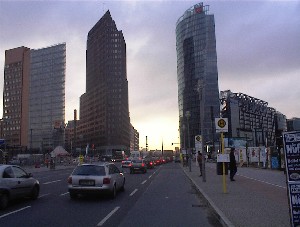 edia
attraction Music Box and a large Sony shop. The courtyard of the Sony Center
seems to be indoors but is not. We have lunch in the Sony Center at 'Billy
Wilder' . Across from Sony Centre Daimler Benz has hired architects like Renzo
Piano (Centre Pompidou, New Metropolis) and Richard Rogers (Millennium Dome) to
design a number of separate buildings, with similar attractions as the Sony
Centre has. Among them a 3D Movie Theatre. We move on to the Leipziger Platz,
which has not been finished yet. We continue along the former Prussian
parliament, now the seat of the Federal Council or Bundesrat, a kind of Senate.
We turn right into the Wilhelmstrasse and pass the former Ministry for the
Airforce, a typical exampel of Nazi-archtecture, large, grey and imposing.
Strangely enough it survived the war fairly unscathed and is now in use by the
federal Treasury department. We then get to the Niederkirchnerstraße. Here we
find,along a vacant lot on which once stood the Gestapo Head Quarters (together
with a couple of other instutions of Nazi-terror), some remains of the Berlin
Wall. The area behind
edia
attraction Music Box and a large Sony shop. The courtyard of the Sony Center
seems to be indoors but is not. We have lunch in the Sony Center at 'Billy
Wilder' . Across from Sony Centre Daimler Benz has hired architects like Renzo
Piano (Centre Pompidou, New Metropolis) and Richard Rogers (Millennium Dome) to
design a number of separate buildings, with similar attractions as the Sony
Centre has. Among them a 3D Movie Theatre. We move on to the Leipziger Platz,
which has not been finished yet. We continue along the former Prussian
parliament, now the seat of the Federal Council or Bundesrat, a kind of Senate.
We turn right into the Wilhelmstrasse and pass the former Ministry for the
Airforce, a typical exampel of Nazi-archtecture, large, grey and imposing.
Strangely enough it survived the war fairly unscathed and is now in use by the
federal Treasury department. We then get to the Niederkirchnerstraße. Here we
find,along a vacant lot on which once stood the Gestapo Head Quarters (together
with a couple of other instutions of Nazi-terror), some remains of the Berlin
Wall. The area behind
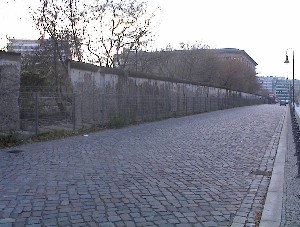 it
where once the Gestapo, the Sicherheitssdienst, the SS, the party offices of the
NSDAP were based has been leveled and never rebuilt. Alongside the wall some
remains of the former prison cellars can be seen, which are used for a permanent
exhibiton called Topographie des Terrors,
Next door is the Martin
Gropius Bau (design 1877). The architect Martin Gropius was a student of the
architect Schinkel and uncle to Bauhaus guru Walter Gropius. The neo-renaissance
building housed until its destruction in the war, the Kunstgewerbemuseum (now at
Kulturforum). The building was reconstructed in 1978 and now offers room to
exhibitions in the field of art, photographie and architecture.
it
where once the Gestapo, the Sicherheitssdienst, the SS, the party offices of the
NSDAP were based has been leveled and never rebuilt. Alongside the wall some
remains of the former prison cellars can be seen, which are used for a permanent
exhibiton called Topographie des Terrors,
Next door is the Martin
Gropius Bau (design 1877). The architect Martin Gropius was a student of the
architect Schinkel and uncle to Bauhaus guru Walter Gropius. The neo-renaissance
building housed until its destruction in the war, the Kunstgewerbemuseum (now at
Kulturforum). The building was reconstructed in 1978 and now offers room to
exhibitions in the field of art, photographie and architecture.
We n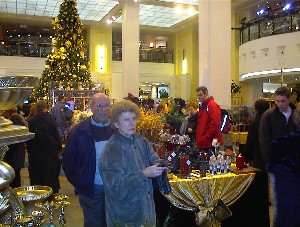 ow
take a bus to Kurfurstendamm and go for some shoping at KaDeWe,
or Kaufhaus des Westens Berlin’s most prestigious department store. Its sixth
floor in particular with its excelent range of delicatessen (which can be eaten
at the spot, watered down with a glass of champagne) is a sight in its own
right.
ow
take a bus to Kurfurstendamm and go for some shoping at KaDeWe,
or Kaufhaus des Westens Berlin’s most prestigious department store. Its sixth
floor in particular with its excelent range of delicatessen (which can be eaten
at the spot, watered down with a glass of champagne) is a sight in its own
right.
At night we have dinner in the Offenbach stuben in Prenzlauer Berg. Already in the GDR days this restaurant had a reputation for its good food. The fare is German, but very tasty, the furnishings a bit theatrical, but still intimate . After a short break at the guest hous, we explore the gayscene in the Schöneberg area.

